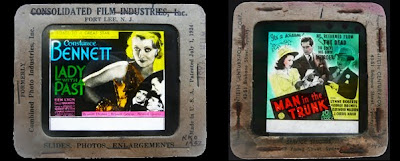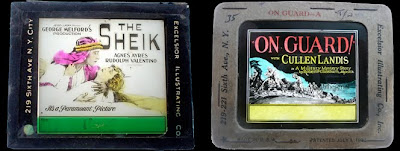Anatomy of a Slide
July 22, 2010
While magic lantern slides came in many formats and sizes, only two sizes were used within the context of professional cinema. Slides used in the United States were a standardized rectangular 3 ¼ x 4 inches, while outside the U.S. the dimension most commonly used is 3 ¼ inch square.

Slide construction can be found in two basic designs: a double-pane construction consisting of two pieces of glass held together by a tape binding around the edge, or a single pane of glass surrounded by a double thick cardboard frame. Slides were originally developed with the double-pane design wherein one pane of glass bears the photographic emulsion containing the image and the second pane is placed over the emulsion to protect the image. The two panes are then bound together, usually with black adhesive tape or paper. Most commercial slide manufacturers also included a thin paper border between the glass plates prior to sealing on which was printed the manufacturers name and address as is the case with the example on the left pictured below.

In 1924 a new construction method came into practice. This innovative design surrounded the image-bearing glass with a thick cardboard frame and eliminated the pane of protective glass required by the double-pane design. According to the April 9, 1923 patent application, only "a single piece of glass is used, thus affording a considerable saving in the material," furthermore noting that slides using the old double-pane construction "are heavy to handle" and thereby expensive to ship. The patent for this innovation (U.S. patent #1,500,025) was granted July 1, 1924 and this date can often be found printed on slides manufactured using this design (a source of endless confusion to eBay sellers who often assume it is the release date for the film).
Despite the presumed advantages of the cardboard frame design, double-pane construction was not abandoned and continued to be used into the 1980s. Therefore, while you can be certain that a slide framed with cardboard was manufactured after the April 1923 patent application, the inverse does not necessarily hold true.
